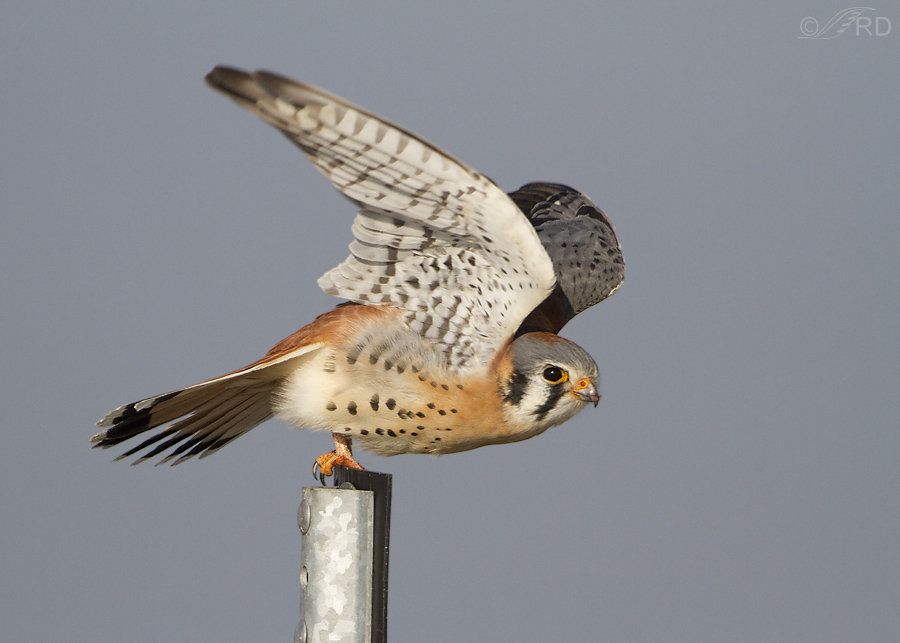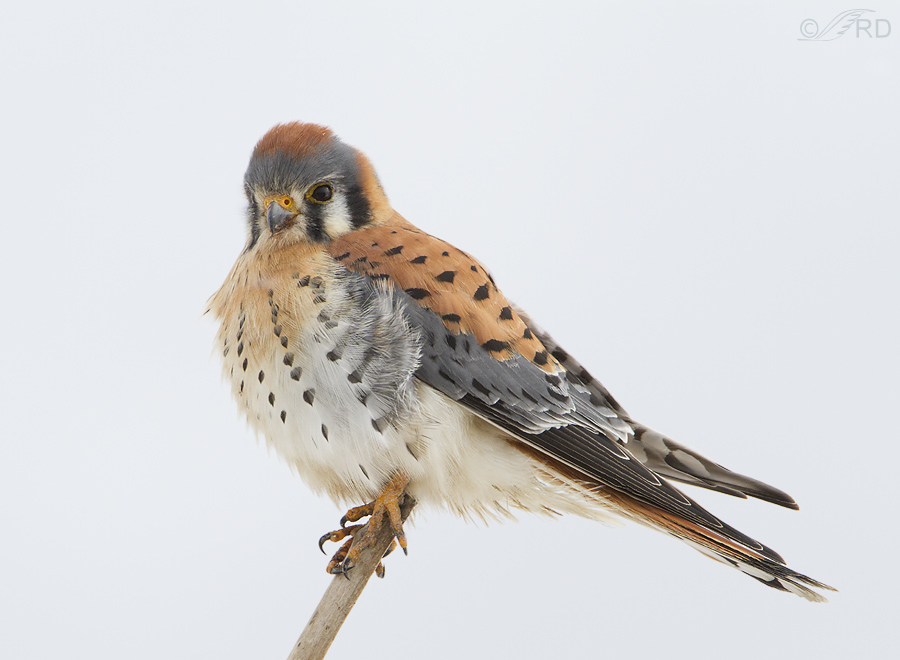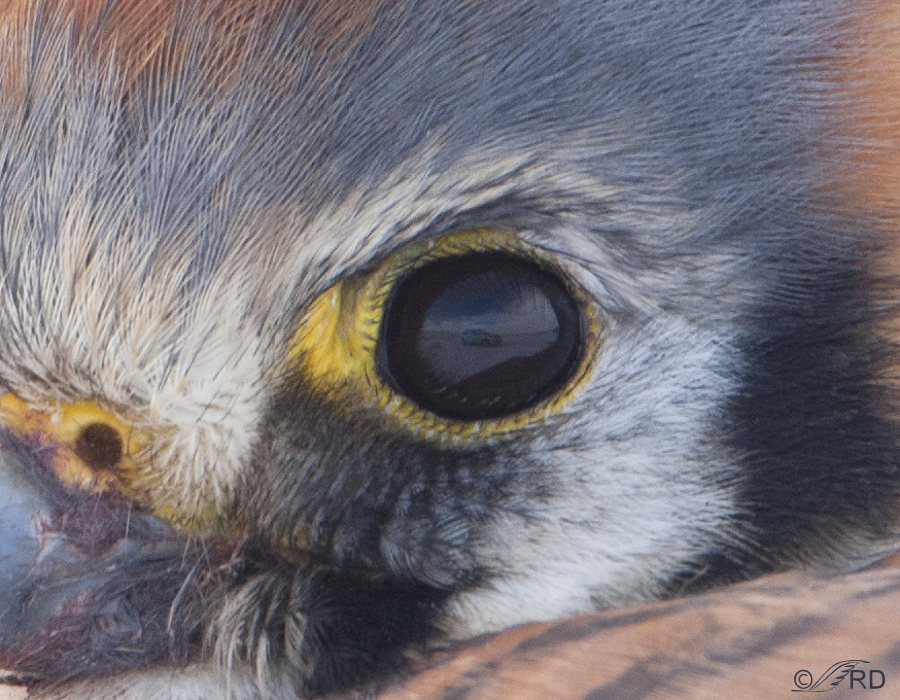One of the first lessons bird photographers learn (often to their great frustration) is that you must get close to your subject in order to get good detail. Very close. Even if you’re shooting with a long, expensive lens. And getting close usually ain’t easy! Large crops rob detail. I’m of the opinion that cropping away any more than about 50% of the image generally does unacceptable damage to image quality.
Some species are relatively easy to approach – around here American Robins, Mourning Doves and House Finches come to mind. Other species have a reputation of being particularly skittish and at the top of that list for many photographers is the American Kestrel – a strikingly beautiful little falcon that is found throughout most of North America.
For many years I’ve posted bird images on an internet avian critique forum and whenever I’d post a shot of a kestrel I’d invariably get comments that went something like this: “How in the world did you ever get this close to a kestrel? I always see them perched up high on poles or wires and whenever I even begin to get close they fly away”.
Well, here’s the secret – photograph them when it’s cold. Very cold! That means in the depths of winter. It also means in the early mornings on those days when it’s coldest of all. I’ve found that many species of birds are more reluctant to fly in the cold but that tendency seems to be magnified with the kestrel. I’m not sure why but as a photographer I’m more than happy to take advantage of the situation (even though it often means freezing my butt off to get the shot).
I call the reluctance of birds to fly when it’s cold “being sticky”.
In each of the images below, note two things: the percent of crop as an indicator of how close I was to the kestrel and the month the image was taken as an indicator of the effect of the cold which allowed me to get closer than normal to the falcon. All of these images were taken in the early morning on very cold days.

1/2500, f/6.3, ISO 500, 500 f/4, 1.4 tc, natural light, not baited, set up or called in
Shooting in the cold doesn’t guarantee attractive, natural perches and this ugly, metal post is a perfect example of that but I think you can see that I was close to the bird. Cropped to 84% of the original image. Photo taken on December 9.

1/400, f/10, ISO 500, 500 f/4, 1.4 tc, natural light, not baited, set up or called in
Another potential problem with shooting on winter days is that you often get featureless skies or snow as a backdrop which usually makes for high key backgrounds. Some like them, some don’t. Cropped to 80% of original image. Photo taken on January 24.

1/2000, f/8, ISO 400, 500 f/4, 1.4 tc, natural light, not baited, set up or called in
Another male, this time perched on rabbitbrush. Cropped to 84% of the original image. Photo taken on January 2.

1/2000, f/9, ISO 500, 500 f/4, 1.4 tc, natural light, not baited, set up or called in
If you can find them with prey when it’s cold they’re even “stickier” than usual. Interestingly this is a mouse instead of a vole (note the long tail). I seldom see them with mice but this shot was taken fairly close to human habitation which probably explains it. Another ugly perch but this shot is full frame (no crop). Photo taken on January 7.

1/1250, f/7.1, ISO 400, 400 f/4, 1.4 tc, natural light, not baited, set up or called in
This cooperative female was stretching and basking in the warming sun just as it came over the mountains in an effort to warm up a little. Cropped to 78% of original image. Photo taken on February 8.

1/2500, f/7.1, ISO 400, 500 f/4, 1.4 tc, natural light, not baited, set up or called in
This image shows evidence of just how cold it was. There had been a blizzard the night before that blew snow so that it stuck on the south side of the perch. Cropped to 91% of original image. Photo taken on January 14.

1/1250, f/8, ISO 400, 500 f/4, 1.4 tc, natural light, not baited, set up or called in
I got closer to this female that I’ve ever been, before or since, to a wild kestrel. She was perched on an ugly hunk of concrete so I decided to see how close she’d let me get. I finally quit inching forward before she flew off because I so enjoyed being that close to her even though I knew I couldn’t get any very good shots because of the perch, light and background. When I was through photographing her I slowly backed away and she was still there when I left. She was a little messy with dried blood on her face from her last meal. Cropped to 70% of original image. Photo taken on January 3.

Just for the fun of it I cropped extremely tight on her eye to see what might be visible in the reflection. Ahaaa, there it is – the silver Toyota Matrix I was shooting out of.
I’m truly convinced that the secret to getting close, detailed images of kestrels is to shoot in the cold, using your vehicle as a mobile blind. And the colder the better. Obviously you still need to use stalking skills to approach them closely but your chances improve astronomically when it’s frigid. Really!
And winter’s coming on! (at least for those of us in temperate climes…)
Ron
PS – In thinking back, I don’t recall ever getting a good, detailed shot of a kestrel when it wasn’t either winter or a very cold late fall or early spring day.


Thank you a thousand times over for this wonderful tip! I have so wanted to get close enough to a kestrel to get a good shot. All of my kestrel shots are from so far away that there is no detail. I see one resting on a post, I start creeping closer and off it flies only to land two or three posts further away. This will repeat a few times until I give up or the bird flies off out of sight.
Now I can’t wait for winter.
You are an inspiration to me and your raptor shots are the best I’ve ever seen.
Sharon
Thanks very much Sharon. The frustrations you describe are exactly what happens to me with kestrels for most of the year too but come winter the situation improves drastically – not every time, but often enough to make for some nice shots.
Thank you so much Ron for sharing your crop techniques. As a beginner I find your post extremely helpful.
You’re certainly welcome Bob.
incredible! love the reflection shot! Thanks for the tips
Thank you Rolando.
Truly amazing shots… I’ve never seen anything like them. Such beautiful colors they sport!!
Their colors are beautiful Christina – both sexes. The female is a little more subtle but still stunning.
I’m glad you liked the close-up of the eye reflection Tana and Elephant’s Child. I was undecided as to whether I should include it or not.
Brilliant. I was particularly impressed with the detail in the shot that you cropped to show the reflection in the bird’s eye. Such a beautiful bird. Thank you.
Oh, so interesting about the cold, and it makes sense. These little guys are one of my favorites because they are so ubiquitous, and so beautiful. The extreme close up of the head with the reflection in the eye is just amazing. Thank you for sharing your expertise and your talent.
Great shots. As a falconer who has trapped and hunted these gorgeous birds, the detail explodes as you get closer. Another trick to getting close is to look for them on highly traveled entrance roads in industrial parks with a high volume of “to and from work” traffic. These birds are not afraid of slow moving cars and i have often gotten directly under them on low hanging wires without them being spooked on early Sunday mornings. Kestrels on isolated rural highways almost always “bump” when approached.
Thanks for the additional tips Metrix.
I have a special affection for American kestrels. I love seeing them, observing them, and trying, to no avail, to photograph them. I do so often. I guess I’ll have to make some sub-zero trips to try. These are gorgeous!
It really works Katie – give it a try.
Beautiful!!!! Seems as though you have genes that are heavy with TALENT!!!
Thanks very much Nicole but it’s probably more perseverance than talent.